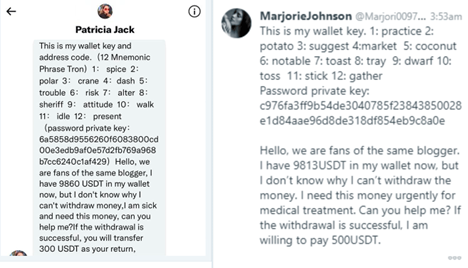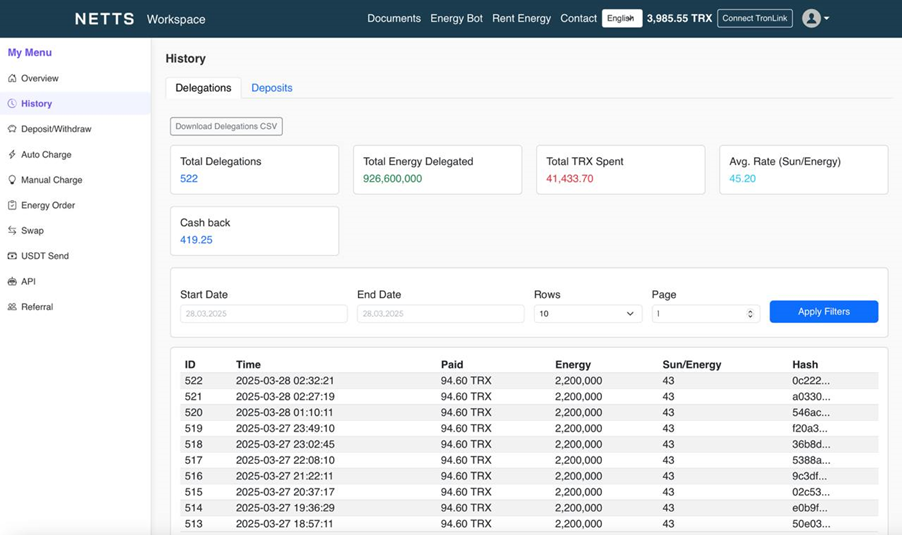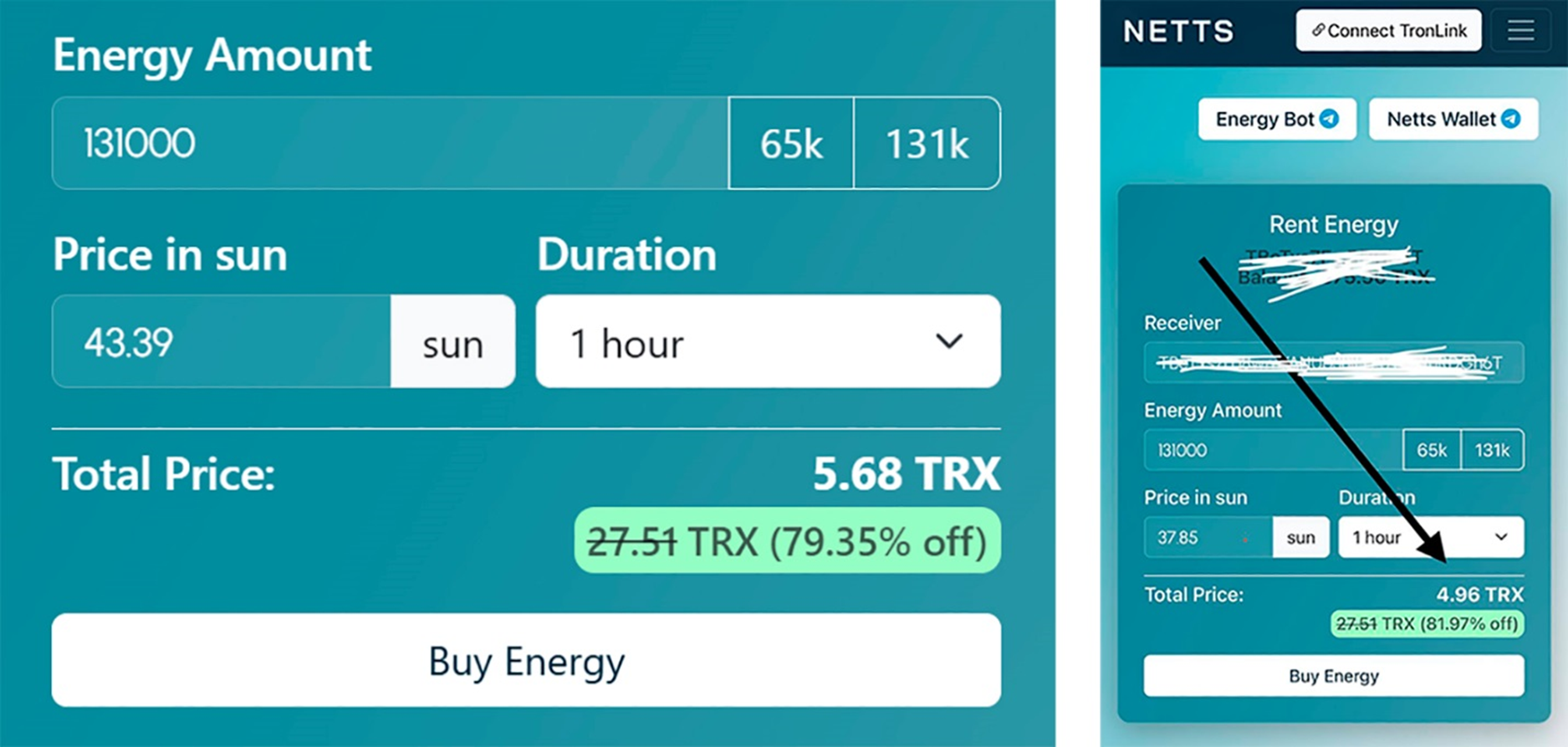How to Avoid Fake Services and Scammers on the Tron Network
The demand for any product in any field, including the cryptocurrency business, attracts the attention of scammers. The rapidly growing Tron cryptocurrency blockchain, which has made its USDT TRC-20 stablecoin a leader, is no exception. This token, pegged to the US dollar exchange rate (1:1), is most actively used by the cryptocurrency community for transfers. The reason is Tron's high throughput (up to 2000 transactions per second), low commissions, and flexible gas fee system.

Naturally, as the popularity of the Tron network grew, so did the number of fake services and scammers targeting users. The eco-platform's efforts to combat fraudulent platforms have not yet led to their final expulsion from the blockchain.
Therefore, it is important for users to be able to distinguish reliable platforms from fake ones to protect their funds.
We provide recommendations for recognizing fraudulent services in the Tron ecosystem and explain how to distinguish them from reliable platforms.
Let's consider the main signs of fraudulent services and give recommendations for choosing reliable platforms.
Common Scam Schemes on the Tron Network
Let's consider the main signs of fraudulent services from the point of view of the user deception mechanism used.
Among the most popular scam schemes on the Tron network are those related to the blockchain's native crypto TRX and the stablecoin created by Tether Limited specifically for the Tron system.
Multisignature Scams
One of the most common schemes, which is constantly being modified to catch new users. This scam method is based on the multisignature function, which was developed and implemented on the Tron network precisely to prevent theft. The function is that not one user, but several, can use a wallet. In this case, a transaction occurs with several signatures. Compare this to the method of storing keys to one safe by several bank employees.
Excellent idea, but attackers found a loophole here too. They convince victims to send supposedly missing TRX tokens to pay the commission for withdrawing USDT, promising a percentage of the transfer amount, for example, or even the amount on the balance. "I have 500 USDT, but no TRX to pay for their withdrawal. Could you help me, here is my seed phrase." And the victim indeed gains access to the wallet with the promised balance. But the victim does not pay attention to the fact that they do not control the wallet itself. The listed commissions go to the scammer.
If a user is not in the habit of checking their account permissions or has not transferred assets for a long time, they usually will not notice the changes made by the scammer. Who can take advantage of this when a significant amount of assets accumulates on such a user's balance, and transfer them to their own wallet.

The second option is to fraudulently obtain access to private keys or seed phrases. And here, success depends on the scammer's charm and knowledge of psychology.
Fake Wallets and Applications
Fake applications and fake wallets steal both user data and their funds.
The events of 2022 are widely known – a scam using the Trust wallet (Trust Wallet) cost web-3 users 4 million dollars.
And of course, scammers were particularly pleased in May 2023 to learn that Trust Wallet now supports the Tron network, meaning it allows interaction with native TRX crypto, USDT, and USDC stablecoins.
The scammer's goal is to convince the user to sign a transaction, which facilitates access to the victim's funds. The "profitable" offer can be anything – from fake, quickly recoupable investments in DeFi, a new (equally fake) token – any pretext that requires a signature. This will facilitate the redirection of funds to the attacker's account.
Phishing Sites
Sites are created that mimic official Tron services, through which user data is stolen. These schemes are also based on the user losing control over their accounts.
An example is fake sites with an airdrop marketing strategy, where an unsolicited distribution of a token or native crypto coin is allegedly made for free to a large number of addresses on the network. By reacting to such an offer, users open access for scammers to their assets.
Zero Transfer Phishing
This type of scam was discovered on the Tron network in 2023, when it became known that as a result of such transfers, users lost more than 451 million USDT (TRC-20).
In this case, attackers do not even need to know the user's key – they send zero-value transactions simply so that their addresses appear in the victim's transaction history.
Often in such fraudulent schemes, addresses are used that at first glance look similar to those where the victim sends assets. Attackers may leave the same set of characters at the beginning and end of the address line.
If the user is not in the habit of carefully checking the recipient's address, they simply compare the initial and final characters of the address line, copy it, and send their tokens or other assets directly to the scammer's address themselves.
Signs of Reliable Services in the Tron Ecosystem
How to determine if a service is safe? First of all, a Tron user (and not necessarily with a significant balance in their wallet) should always remember that scammers will definitely take advantage of a loss of vigilance. Therefore, before contacting any service built on the Tron platform, pay attention to the main parameters that can identify an attacker even at the approach.
- Regulation and Licenses. Reliable platforms are regulated by financial (fiscal) authorities and have licenses.
- Team Transparency. Open information about developers and the company.
- Positive Reviews. Recommendations from users on independent sites and forums.
- Security. Two-factor authentication, data encryption, protection against hacking.
How to Check the Reliability of a Service Before Using
To verify the reliability of any service offering its services on the Tron network, a statement on the main page of this service that it fully complies with legal requirements is not enough.
Simple steps to check the reliability of a service on the Tron network:
- Check the domain and security certificate (SSL) – be guided by the fact that official sites use HTTPS;
- Study the documentation – be guided by the fact that reliable projects have a White Paper, API documentation;
- User reviews – be guided by the ratio of positive and negative assessments given in comments on forums and social networks;
- Test transactions – an effective verification method that helps to ensure the service's functionality by transferring small amounts;
- Use TronScan – the official Tron blockchain explorer to check suspicious addresses, and better yet – all unknown and even supposedly known ones.
NETTS Energy Rental Service. Principles of Operation and Security Guarantees
The recently launched NETTS Energy rental service raises no doubts among Tron users, as it meets all the criteria of a legal platform on this blockchain. The service's goal is to provide users with the necessary volume of the special Energy resource, which is used on the Tron network to pay transaction fees. As a result, the gas fee is reduced by 5 times compared to burning TRX and more than 3 times compared to investing in staking.

Why Users Trust NETTS
- Regulation. The NETTS Energy rental service operates legally and complies with financial requirements in full accordance with the legislation in this area.
- Transparency. All information about the company is publicly available with the appropriate required confirmations.
- Security. The service uses encryption, account protection, and transaction monitoring.
- 24/7 Support. Ready to help at any time of the day or week.
Tron system users can use either the Netts Energy Charge Bot (deposit 15 TRX) or the web interface (deposit 1 TRX when creating an account in Workspace) to replenish their Energy resource balance, or fill out an application form for a one-time delivery with prepayment (the amount depends on the volume of rented Energy).
The peculiarity of the web interface is that those who need constant (round-the-clock) Energy balance replenishment can connect via API. You set a minimum below which the Energy level in your wallet should not fall – this is a trigger delivery in Smart mode. For more frequent transfers, NETTS clients also choose Host mode – continuous Energy delivery or cyclical – according to your schedule.
From this moment on, you no longer need to worry about the availability of this resource in your wallet – you simply make transactions without being distracted by balance control. The need for preliminary accurate calculation also disappears – you simply take as much Energy as is required for each transaction. At the same time, you are not dependent on TRX volatility, as in staking, nor on the state of the network.

By the way, if the network conditions allow, then with low system load, the NETTS Energy rental service mechanism will deduct from your deposit only the amount for the Energy actually used. From the screenshots below, you can see that the TRX deduction from the deposit differs during the day and at night, even without peak overloads, but simply in the normal operation mode of the blockchain.

And assess your savings on transactions when using rented Energy – about 80%!!! There are no such offers on the market yet – proven in practice. The service team constantly conducts marketing research, knowing the Energy rental market perfectly. Therefore, it always has a sufficient volume of this resource to meet any needs for it.
Conclusion
Be careful when choosing services on the Tron network. Scammers create fake platforms to conduct phishing attacks on users' wallets. In doing so, they even create analogs of existing sites and services with minor additions to the official names. A user, thinking that this is an extension, for example, of the TronScan explorer (yes, there is such a case in the history of fraud on the Tron network) trusts it with their data, which is then used to steal funds from the victim's wallet.
Therefore, be sure to check platforms before entrusting them with your funds. These are quite simple and accessible steps, neglecting which can cost significant asset losses.
NETTS service offers safe Energy rental at any time of any day and a convenient API. All information about the service is publicly available. Try it right now by depositing just 1 TRX into Workspace! And from that moment on, 80% of your TRX will not burn in the fire of transactions. Find a better use for them!